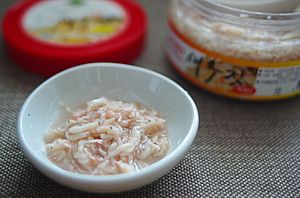Saeu-jeot facts for kids
 |
|
| Alternative names | Salted shrimp |
|---|---|
| Type | Jeotgal |
| Place of origin | Korea |
| Main ingredients | Shrimp |
| Korean name | |
| Hangul |
새우젓
|
|---|---|
| Revised Romanization | saeu-jeot |
| McCune–Reischauer | saeu-chŏt |
| IPA | [sɛ̝.u.dʑʌt̚] |
Saeu-jeot (새우젓) is a special kind of food from Korean cuisine. It's made by salting and fermenting small shrimp. Fermenting means letting food change naturally over time, often with the help of good bacteria. This process helps preserve the food and gives it a unique flavor.
Saeu-jeot is a type of jeotgal, which is a general name for salted and fermented seafood in Korea. It's one of the most popular jeotgal dishes in South Korea, along with myeolchi-jeot (salted anchovy). The name Saeu-jeot comes from two Korean words: saeu (새우), meaning shrimp, and jeot, meaning salted seafood.
This salty shrimp paste is used a lot in Korean cooking. It's especially important as an ingredient in kimchi, which is a famous Korean side dish. It's also used in dipping sauces. The shrimp used for Saeu-jeot are called jeot-saeu. They are usually smaller and have thinner shells than regular shrimp. For the best Saeu-jeot, the shrimp need to be very fresh when they are caught. Sometimes, fishermen add salt right away to keep them fresh, especially in warm weather.
Contents
Different Kinds of Saeu-jeot
There are many types of Saeu-jeot. They are named based on the kind of shrimp used and when they are caught. This is because the shrimp change throughout the year.
Saeu-jeot from Spring
- Putjeot: This type is made from shrimp caught between late January and April. On the west coast of South Korea, it's also known as deddeugi jeot or dotddegi jeot.
- Ojeot: This Saeu-jeot uses shrimp harvested in May.
Saeu-jeot from Summer
- Yukjeot: This is made with shrimp caught in June. Many people think Yukjeot is the best kind of Saeu-jeot. It's often preferred for making kimchi because it has a richer flavor. The shrimp in Yukjeot are bigger and often have red heads and tails.
- Chajeot: This type is made from shrimp harvested in July.
Saeu-jeot from Fall
- Gonjaeng-ijeot: Also called jahajeot, this kind is made from very tiny shrimp-like creatures. They are part of the opossum shrimp family. These tiny shrimp are harvested in August and September. They are found where freshwater and seawater mix in the deep parts of the Yellow Sea. As it ferments, Gonjaeng-ijeot changes color from clear to light purple or brown. It also becomes softer. In some areas, like Jeolla Province, it's called gogaemijeot.
- Chujeot: This Saeu-jeot is made from small shrimp caught in autumn. These shrimp are usually smaller and look cleaner than the ones used for Yukjeot.
Saeu-jeot from Winter
- Dongjeot: This type uses shrimp harvested in November.
- Dongbaekha: This Saeu-jeot is made from white, clean shrimp caught in February.
Other Unique Saeu-jeot Types
- Tohajeot: This special Saeu-jeot is made from toha, which are small shrimp found only in very clean freshwater valleys. It's a local specialty from South Jeolla Province. It's also known as saengijeot.
- Jajeot: This is often called japjeot, which means "mixed jeot." It's made from different kinds of small shrimp that are not specially sorted.
- Daetdaegijeot: This type uses shrimp with thick, stiff, yellowish shells. It's generally considered the lowest quality Saeu-jeot.
- Saeualjŏt: This unique Saeu-jeot is made from the eggs of medium-sized red shrimp. These eggs are harvested in April. Long ago, during the Joseon dynasty, this was a special food sent to the royal court. Today, it's only made in a specific area called Okgu-gun in North Jeolla Province.
See also
 In Spanish: Saeujeot para niños
In Spanish: Saeujeot para niños

